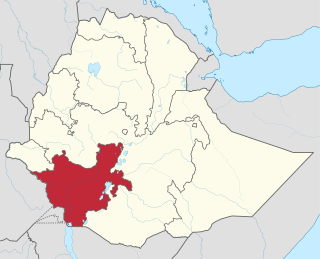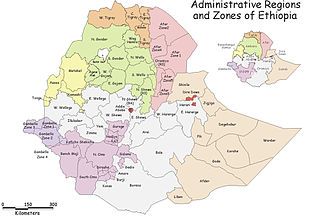Demographics
Based on figures published by the Central Statistical Agency in 2005, this woreda has an estimated total population of 109,064, of whom 53,437 are men and 55,627 are women; 5,500 or 5.04% of its population are urban dwellers, which is less than the Zone average of 8.5%. With an estimated area of 1,301.72 square kilometers, Zala Ubamale has an estimated population density of 83.8 people per square kilometer, which is less than the Zone average of 156.5. [1]
The 1994 national census reported a total population for this woreda of 76,555 of whom 39,073 were men and 37,482 were women; 3,036 or 3.97% of its population were urban dwellers. The five largest ethnic groups reported in Zala Ubamale were the Gezo (50.34%), the Gofa (30.34%), the Aari (11.5%), the Male (2.64%), the Amhara (2.18%), and the Gamo (0.72%); all other ethnic groups made up 2.28% of the population. Gezo is spoken as a first language by 73.51%, 12.13% Aari, 8.01% Oyda, 3.28% Male, and 1.76% spoke Amharic; the remaining 1.76% spoke all other primary languages reported. [2]

The Southern Nations, Nationalities, and Peoples' Region was a regional state in southwestern Ethiopia. It was formed from the merger of five kililoch, called Regions 7 to 11, following the regional council elections on 21 June 1992. Its government was based in Hawassa.

South Omo Zone is a zone in the Ethiopian South Ethiopia Regional State. South Omo is bordered on the south by Kenya, on the southwest by the South Sudan, on the west by Bench Maji, on the northwest by Keffa, on the north by Konta, Gamo Gofa and Basketo, on the northeast by Dirashe and Konso, and on the east by the Oromia Region. The administrative center of South Omo is Jinka.

North Omo Zone was a zone in the Southern Nations, Nationalities, and Peoples' Region of Ethiopia. It was named after the Omo River, which flows in the western area of the former zone. In 2000 it was split into three zones: Dawro, Gamo Gofa, and Wolayita; and Basketo and Konta became special woredas.

Dirashe Zone is one of the zones in the South Ethiopia Regional State of Ethiopia. In 2011, the Segen Area Peoples Zone was established, which includes Dirashe woreda and the 3 former special woredas surrounding it. It is named for the Dirashe people, whose homelands lie in the eastern part of this woreda. Dirashe got zonal status when the South Ethiopia Regional State formed in August 2023.

Konta, previously called Ela, is a zone in the Southwest Region of Ethiopia. It is named after Konta people who speak the dialects called Kontatsuwa, Omotic languages. Before joining to Southwest Ethiopia Regional states, Konta was special woreda. This zone is bordered on the south by the Omo River which separates it from the Gamo Zone, Gofa Zone, and Selamgo woreda, Debub Omo Zone, on the west by the Keffa Zone, on the north by the Gojeb River which separates it from the Oromia Region, and on the east by the Dawro Zone; the Denchya River defines the southern part of the boundary with the Keficho Shekicho Zone. The administrative center is Ameya; other towns include Chida.
Loma Bosa was one of the 77 woredas in the Southern Nations, Nationalities, and Peoples' Region of Ethiopia. Part of the Dawro Zone, Loma Bosa was bordered on the south by the Gamo Gofa Zone, on the west by Isara Tocha, on the northwest by Mareka Gena, on the north by the Kembata Tembaro Zone, and on the east by the Wolayita Zone; the Omo River defined Loma Bose's boundary on the northeast, east and south. The major town in Loma Bosa was Loma Bale. Loma Bosa was divided for Loma and Gena Bos woredas.
Isara Tocha was one of the 77 woredas in the Southern Nations, Nationalities, and Peoples' Region of Ethiopia. Part of the Dawro Zone, Isara Tocha was bordered on the south by the Omo River which separates this woreda from the Gamo Gofa Zone, on the west by the Konta special woreda, on the north by the Gojeb River which separates it from the Oromia Region, on the east by Mareka Gena, and on the southeast by Loma Bosa. Towns in Isara Tocha included Bale and Tocha. Isara Tocha was separated to Isara and Tocha woredas.

Basketo Zone is a zone in the South Ethiopia Regional State of Ethiopia, named after its inhabitants, the Basketo people. It was formerly a part of the Southern Nations, Nationalities and Peoples' Region (SNNPR)'s, and because Basketo was not part of any administrative Zone in the SNNPR, it was considered a special woreda—an administrative subdivision which is similar to an autonomous area.
Dita Dermalo was one of the 77 woredas in the Southern Nations, Nationalities, and Peoples' Region of Ethiopia. Part of the Gamo Gofa Zone, Dita Dermalo was bordered on the south by Bonke, on the southwest by Kemba, on the west by Zala Ubamale, on the north by Kucha, and on the east by Chencha. Towns in Dita Dermalo included Wacha and Zeda. Dita Dermalo was separated to Dita and Deramalo woredas.
Kemba is one of the woredas in the Southern Nations, Nationalities, and Peoples' Region of Ethiopia. Part of the Gamo Gofa Zone, Kemba is bordered on the southwest by the Debub Omo Zone, on the west by Uba Debretsehay, on the northwest by Zala, on the northeast by Deramalo, on the east by Bonke, and on the southeast by the Dirashe special woreda; the Weito River defines the boundary with Bonke and Dirashe. The major town in this woreda is Kemba.
Selamago is a woreda in the Southern Nations, Nationalities, and Peoples' Region of Ethiopia. Part of the Debub Omo Zone, Selamago is bordered on the south by Nyangatom, on the west and north by the Omo River which separates it from the Bench Maji, Keffa and Konta, on the northeast by the Gamo Gofa, on the east by the Basketo and Bako Gazer, and on the southeast by the Usno River which separates it from Bena Tsemay; the Mago River defines part of the boundary with Bako Gazer. The administrative center of Selamago is Hana.
Bako Gazer is one of the woredas in the Southern Nations, Nationalities, and Peoples' Region of Ethiopia. It is also called Southern Aari as it is part of the homeland of Aari people. Part of the Debub Omo Zone, Bako Gazer is bordered on the south by Bena Tsemay, on the west by the Mago River which separates it from Selamago, on the north by the Basketo special woreda and Gelila, on the northeast by the Gamo Gofa Zone, and on the east by Male. The administrative center of this woreda is Jinka; other towns in Bako Gazer include Tolta and Wub Hamer. Gelila and Male woredas were separated from Bako Gazer.
Melokoza is one of the woredas in the Southern Nations, Nationalities, and Peoples' Region of Ethiopia. Part of the Gamo Gofa Zone, Melokoza is bordered on the south by Basketo special woreda, on the southwest by the Debub (South) Omo Zone, on the northwest by the Konta special woreda, on the north by the Dawro Zone, and on the east by Demba Gofa and Geze Gofa; the Omo River defines its northwestern boundary separating the woreda from Konta and the Dawro Zone. The major town in Melokoza is Leha.
Gamo Zone is a zone in the South Ethiopia Regional State of Ethiopia. Gamo is bordered on the south by the Dirashe special woreda, on the southwest by Debub (South) Omo and the Basketo special woreda, on the northwest by Konta special woreda, on the north by Dawro and Wolayita, on the northeast by the Lake Abaya which separates it from the Oromia Region, and on the southeast by the Amaro special woreda. The administrative center of Gamo is Arba Minch.

Dawro is a zone in the South West Region of Ethiopia. The name "Dawuro" represents both the land and the people. It is located at about 500km southwest of Addis Ababa, the capital of Ethiopia and 319 km of Hawassa, the capital of the Sidama Region. Dawuro is bordered on the south by Kucha in Gamo Zone, on the west by the Konta Zone, on the north by the Gojeb River which defines its boundary with the Oromia Region,Jimma zone, on the northeast by Hadiya and Tembaro Special Woreda in Central Ethiopia Regional State, and on the east by Wolayita Zone; the Omo River defines its eastern and southern boundaries.
Gelila is one of the woredas in the Southern Nations, Nationalities, and Peoples' Region of Ethiopia. It is also called Northern Aari as it is part of the homeland of Aari people. Part of the Debub Omo Zone, Gelila is bordered on the south by Bako Gazer, on the north by the Basketo special woreda, and on the east by the Gamo Gofa Zone. Gelila was separated from Bako Gazer woreda.
Hamer Bena was one of the 77 woredas in the Southern Nations, Nationalities, and Peoples' Region of Ethiopia. Part of the Debub Omo Zone, Hamer Bena was bordered on the south by Kenya, on the southwest by Kuraz, on the northwest by the Usno River which separates it from Selamago, on the north by Bako Gazer, on the northeast by the Konso special woreda, and on the east by the Oromia Region; the Weito River separated it from Konso and the Oromia Region and the Neri River defined part of the boundary with Bako Gazer. Hamer Bena included part of Lake Chew Bahir along its southeastern border. The administrative center was Dimeka; other towns in Hamer Bena included Arbore, Key Afer, and Turmi. Hamer Bena was separated for Hamer and Bena Tsemay woredas.
Zala is one of the woredas in the Southern Nations, Nationalities, and Peoples' Region of Ethiopia. Part of the Gamo Gofa Zone, Zala is bordered on the southwest by Uba Debretsehay, on the northwest by Demba Gofa, on the northeast by Kucha, on the east by Deramalo, and on the southeast by Kemba. Zala was part of former Zala Ubamale woreda.
Uba Debretsehay is one of the woredas in the Southern Nations, Nationalities, and Peoples' Region of Ethiopia. Part of the Gamo Gofa Zone, Uba Debretsehay is bordered on the south and west by the Debub Omo Zone, on the north by Oyda and Demba Gofa, on the northeast by Zala, and on the east by Kemba. Towns in Uba Debretsehay include Beto. Uba Debretsehay was part of former Zala Ubamale woreda.
Oyda is one of the woredas in the Southern Nations, Nationalities, and Peoples' Region of Ethiopia. It is named after Oyda people living in this woreda. Part of the Gamo Gofa Zone, Oyda is bordered on the south by Uba Debretsehay, on the west by the Debub Omo Zone, on the north by Geze Gofa, and on the northeast by Demba Gofa. Oyda was part of former Gofa Zuria woreda.


